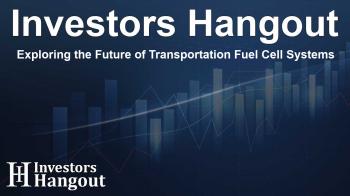Exploring the Future of Transportation Fuel Cell Systems

Transportation Fuel Cell Stack Systems Market: A Growth Perspective
The global transportation fuel cell stack systems market is on an exciting trajectory. Initially valued at US$1.4 billion, forecasts suggest it could skyrocket to US$20.2 billion by 2035, reflecting a remarkable compound annual growth rate (CAGR) of 26.1% during the period leading up to 2035. This analysis sheds light on the driving forces behind this predicted exponential growth.
Understanding Market Dynamics
Diving into the heart of the market reveals various trends and shifts shaping its future. The continuous demand for sustainable transportation solutions is significantly influencing market dynamics. Fuel cell technology, particularly the proton exchange membrane fuel cells (PEMFC), is gaining momentum. PEMFC systems are characterized by their low operational temperatures, efficiency, and scalability, making them the preferred choice for modern applications. This technology's widespread adoption in heavy-duty transport illustrates a robust inclination towards cleaner energy alternatives.
Global Market Insights
Several regions stand out in this growing market, notably aligning with governmental policies favoring green technologies. The Asia-Pacific area is projected to lead, where investments in sustainable solutions, alongside an expansive consumer base, are anticipated to fuel market demand. Governments in this region are significantly pushing for hydrogen infrastructure, positioning the Asia-Pacific as a key player in the future of transportation fuel cell stack systems.
Challenges and Growth Opportunities
While the outlook is promising, challenges persist. The main obstacles include competition from battery technologies, particularly lithium-ion batteries, which are widely used in electric vehicles. However, the unique advantages offered by hydrogen fuel cells, such as rapid refueling and longer ranges, serve as strong counterpoints to these competitors.
Market Segmentation Analysis
Understanding the market segmentation is vital for stakeholders who want to tap into this growth. The segments include fuel cell types and applications, primarily focusing on heavy-duty transportation and light to medium-duty vehicles. Heavy-duty vehicles, driven by hydrogen fuel cell technology, not only promise reduced emissions but also possess better energy density, making them an attractive option for long-distance transport.
Adoption Across Various Sectors
The ongoing transition towards hydrogen as a fuel of the future signifies that the market will continue evolving. Companies and OEMs are rapidly innovating their fleets to include fuel cell technology, making significant strides in sustainability. This adaptation showcases the industry’s focus on reducing carbon footprints while meeting customer demands for efficient transport solutions.
Competitive Landscape
The competitive arena within the transportation fuel cell stack systems market is diverse. Key players include Plug Power Inc., Ballard Power Systems, and Daimler AG, each contributing to the landscape with unique offerings. The competition focuses on service delivery, pricing strategies, and regional market penetration.
Future Implications for Businesses
For businesses operating in or entering the fuel cell sector, an understanding of these dynamics is crucial. Innovations in hydrogen production and distribution networks will expand opportunities, allowing companies to strategize effectively about their market positioning in this evolving space. As demand increases, so will the need for partnerships and collaborations among automakers and energy providers, enhancing research and development efforts.
Frequently Asked Questions
What is the projected growth of the transportation fuel cell stack systems market?
The market is expected to grow from US$1.4 billion to US$20.2 billion by 2035, with a CAGR of 26.1%.
Which region is expected to dominate the market?
The Asia-Pacific region is anticipated to lead the market due to significant investments in sustainable technologies and hydrogen infrastructure.
What fuel cell type is mainly driving market growth?
Proton exchange membrane fuel cells (PEMFC) are predominantly leading the market due to their efficiency and operational advantages.
What challenges do fuel cell technologies face?
Key challenges include competition from lithium-ion batteries and the high production costs associated with fuel cell systems.
What opportunities exist in the fuel cell market?
Opportunities lie in advancements in fuel cell efficiency, expanding hydrogen refueling infrastructure, and growing applications in commercial and heavy-duty transportation.
About The Author
Contact Henry Turner privately here. Or send an email with ATTN: Henry Turner as the subject to contact@investorshangout.com.
About Investors Hangout
Investors Hangout is a leading online stock forum for financial discussion and learning, offering a wide range of free tools and resources. It draws in traders of all levels, who exchange market knowledge, investigate trading tactics, and keep an eye on industry developments in real time. Featuring financial articles, stock message boards, quotes, charts, company profiles, and live news updates. Through cooperative learning and a wealth of informational resources, it helps users from novices creating their first portfolios to experts honing their techniques. Join Investors Hangout today: https://investorshangout.com/
The content of this article is based on factual, publicly available information and does not represent legal, financial, or investment advice. Investors Hangout does not offer financial advice, and the author is not a licensed financial advisor. Consult a qualified advisor before making any financial or investment decisions based on this article. This article should not be considered advice to purchase, sell, or hold any securities or other investments. If any of the material provided here is inaccurate, please contact us for corrections.

